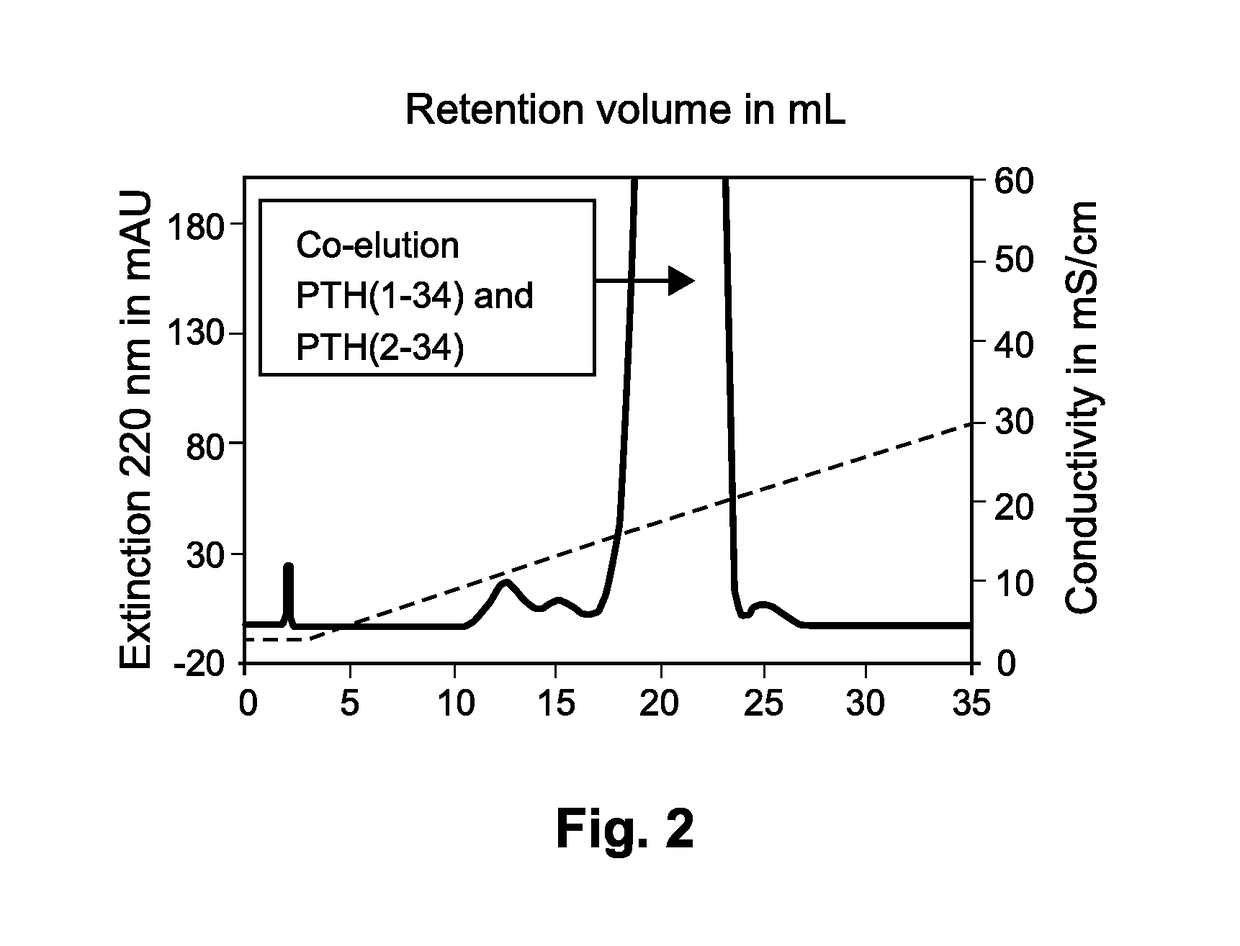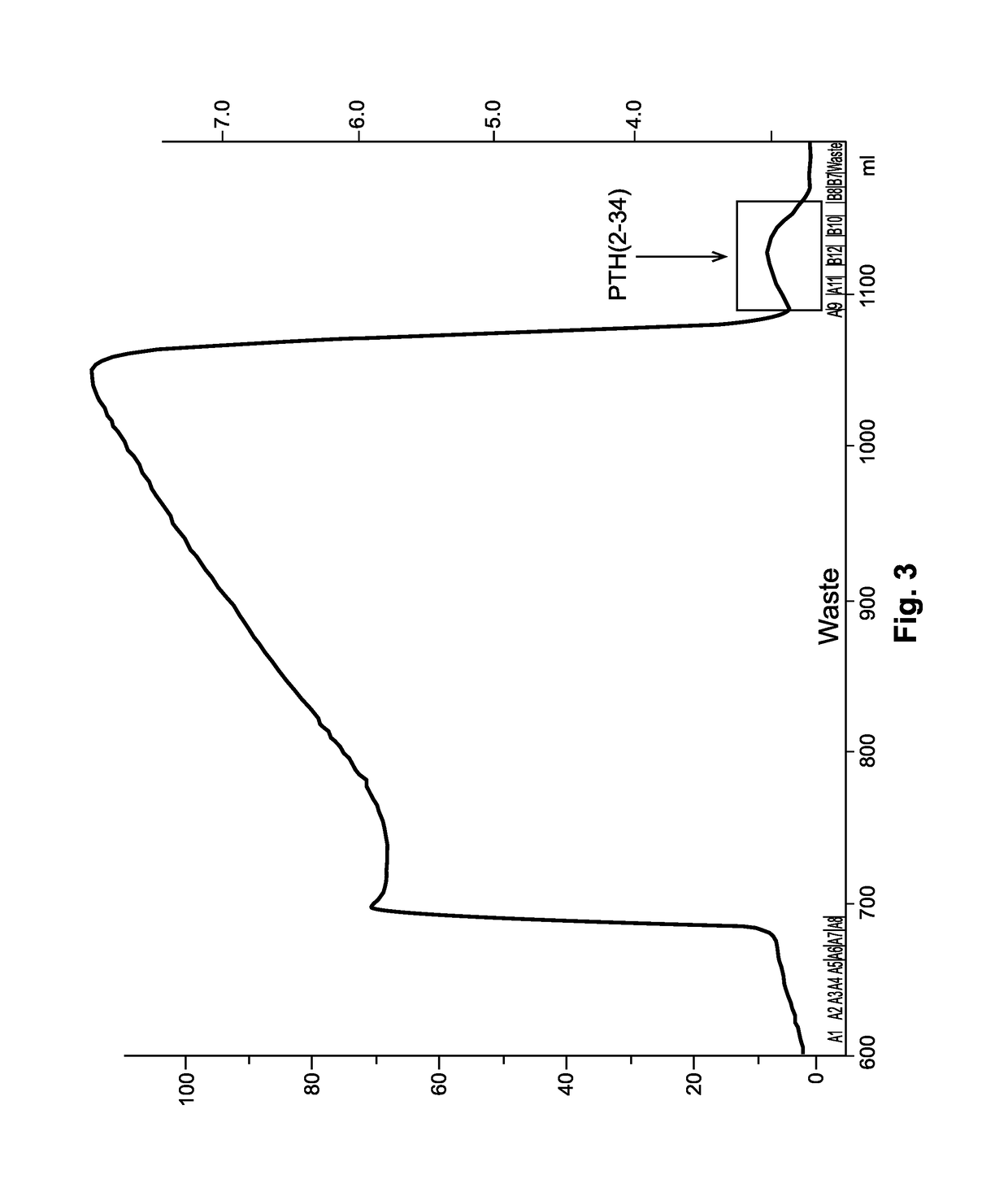Method for purifying teriparatide
a technology of teriparatide and purification method, which is applied in the direction of parathyroid hormone, cation exchanger material, separation process, etc., can solve the problems of truncated or chemically modified form of pth1-34 in the final product, obvious undesirable effects, and bone atrophy
- Summary
- Abstract
- Description
- Claims
- Application Information
AI Technical Summary
Benefits of technology
Problems solved by technology
Method used
Image
Examples
example 1
ion of PTH1-34 on an Analytical Column
[0090]The conditions for separating PTH1-34 from the N-terminally truncated PTH2-34 were analyzed on an analytic Fractogel SO3− (S) cation exchange column with a volume of 1 mL (diameter 0.8 mm, height: 20 mm). Eluate from a reversed phase chromatography containing approximately 0.6 mg / mL PTH1-34 was applied to the column at a load of approximately 1 mg / mL of the resin.
[0091]Binding of the polypeptides to the column was performed in Eluent A (also used as binding buffer) consisting of 20 mM KH2PO4, pH 6.5. Elution was performed by use of Eluent B consisting of 20 mM KH2PO4, 500 mM KCl, pH 6.5. The eluent was applied in a linear gradient of 0-100% eluent in 60 column volumes. The flow rate was 120 cm / h. Fractions of 1 mL were collected. For each of the collected samples, the extinction at 220 nm was measured.
[0092]The result of the chromatography is depicted in FIG. 2. It can be seen that PTH1-34 and PTH2-34 co-eluted in the same peak. It was evi...
example 2
ion of PTH1-34 on a 29 ml Column
[0093]To define robust and reliable scale up conditions, a number of different conditions were tested using a Fractogel SO3− (S) cation exchange column with a volume of 29 mL. Improvements were observed when using an increasing pH instead of an increasing salt concentration for elution. To provide for a low ionic strength during elution, the buffers were prepared such that eluent A (which corresponds to the binding buffer) has a high ionic strength and eluent B has a significantly lower ionic strength. Tris buffer was found to be particularly useful for this approach. The following conditions were tested:
[0094]
Loading[mg / cm2Gradientand mg / mLStep YieldProcess runBuffer Conditions[% B / CV]Resin)[%]P225Eluent A: 20 mM Tris 20 mM2.760 / 676Bis-Tris pH 6.5(40% wash; 40-100%Cond. 2.7 mS / cmelution)Eluent B: 20 mM Tris 20 mMBis Tris 5 mM KCl pH 10.0Cond. 0.8 mS / cmP226Eluent A: 20 mM Tris 20 mM2.565 / 4.573Bis-Tris pH 6.5(45% wash; 45-100%Cond. 2.7 mS / cmelution)Elu...
example 3
ion of PTH1-34 on a 26.3 L Column
[0098]The method of the invention was tested at preparative scale using a Fractogel SO3− (S) cation exchange column having a volume of 26.3 L (column diameter: 450 mm, column height 166 mm). The PTH1-34 preparation used in this chromatographic step was recombinantly expressed PTH1-34 that had previously been subjected to reversed-phase (RP) chromatography. The PTH1-34 preparation obtained from the RP chromatography step contained approximately 1.2% PTH2-34.
[0099]To reduce the acetonitrile concentration, the main fraction obtained from RP chromatography was diluted 1:2 with Eluent A (20 mM Tris, 20 mM potassium dihydrogen phosphate, pH 6.5, conductivity about 4.1 mS / cm) and loaded onto the column. The column was washed with an initial gradient ranging from 0-35% Eluent B (20 mM Tris, 16 mM dipotassium hydrogen phosphate, 4 mM potassium dihydrogen phosphate, pH 8.9, conductivity about 3.5 mS / cm) in one column volume and, in a subsequent step, at 35% El...
PUM
| Property | Measurement | Unit |
|---|---|---|
| molecular mass | aaaaa | aaaaa |
| volume | aaaaa | aaaaa |
| volume | aaaaa | aaaaa |
Abstract
Description
Claims
Application Information
 Login to View More
Login to View More - R&D
- Intellectual Property
- Life Sciences
- Materials
- Tech Scout
- Unparalleled Data Quality
- Higher Quality Content
- 60% Fewer Hallucinations
Browse by: Latest US Patents, China's latest patents, Technical Efficacy Thesaurus, Application Domain, Technology Topic, Popular Technical Reports.
© 2025 PatSnap. All rights reserved.Legal|Privacy policy|Modern Slavery Act Transparency Statement|Sitemap|About US| Contact US: help@patsnap.com



